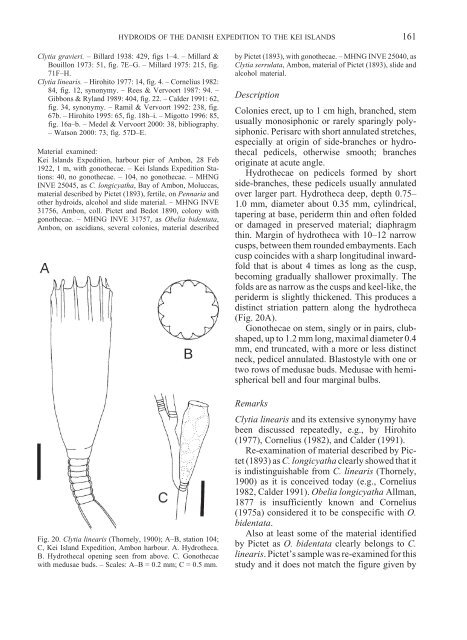Hydroids (Cnidaria, Hydrozoa) of the Danish expedition to
Hydroids (Cnidaria, Hydrozoa) of the Danish expedition to
Hydroids (Cnidaria, Hydrozoa) of the Danish expedition to
You also want an ePaper? Increase the reach of your titles
YUMPU automatically turns print PDFs into web optimized ePapers that Google loves.
HYDROIDS OF THE DANISH EXPEDITION TO THE KEI ISLANDS<br />
Clytia gravieri. – Billard 1938: 429, figs 1–4. – Millard &<br />
Bouillon 1973: 51, fig. 7E–G. – Millard 1975: 215, fig.<br />
71F–H.<br />
Clytia linearis. – Hirohi<strong>to</strong> 1977: 14, fig. 4. – Cornelius 1982:<br />
84, fig. 12, synonymy. – Rees & Vervoort 1987: 94. –<br />
Gibbons & Ryland 1989: 404, fig. 22. – Calder 1991: 62,<br />
fig. 34, synonymy. – Ramil & Vervoort 1992: 238, fig.<br />
67b. – Hirohi<strong>to</strong> 1995: 65, fig. 18h–i. – Migot<strong>to</strong> 1996: 85,<br />
fig. 16a–b. – Medel & Vervoort 2000: 38, bibliography.<br />
– Watson 2000: 73, fig. 57D–E.<br />
Material examined:<br />
Kei Islands Expedition, harbour pier <strong>of</strong> Ambon, 28 Feb<br />
1922, 1 m, with gono<strong>the</strong>cae. – Kei Islands Expedition Stations:<br />
40, no gono<strong>the</strong>cae. – 104, no gono<strong>the</strong>cae. – MHNG<br />
INVE 25045, as C. longicyatha, Bay <strong>of</strong> Ambon, Moluccas,<br />
material described by Pictet (1893), fertile, on Pennaria and<br />
o<strong>the</strong>r hydroids, alcohol and slide material. – MHNG INVE<br />
31756, Ambon, coll. Pictet and Bedot 1890, colony with<br />
gono<strong>the</strong>cae. – MHNG INVE 31757, as Obelia bidentata,<br />
Ambon, on ascidians, several colonies, material described<br />
Fig. 20. Clytia linearis (Thornely, 1900); A–B, station 104;<br />
C, Kei Island Expedition, Ambon harbour. A. Hydro<strong>the</strong>ca.<br />
B. Hydro<strong>the</strong>cal opening seen from above. C. Gono<strong>the</strong>cae<br />
with medusae buds. – Scales: A–B = 0.2 mm; C = 0.5 mm.<br />
161<br />
by Pictet (1893), with gono<strong>the</strong>cae. – MHNG INVE 25040, as<br />
Clytia serrulata, Ambon, material <strong>of</strong> Pictet (1893), slide and<br />
alcohol material.<br />
Description<br />
Colonies erect, up <strong>to</strong> 1 cm high, branched, stem<br />
usually monosiphonic or rarely sparingly polysiphonic.<br />
Perisarc with short annulated stretches,<br />
especially at origin <strong>of</strong> side-branches or hydro<strong>the</strong>cal<br />
pedicels, o<strong>the</strong>rwise smooth; branches<br />
originate at acute angle.<br />
Hydro<strong>the</strong>cae on pedicels formed by short<br />
side-branches, <strong>the</strong>se pedicels usually annulated<br />
over larger part. Hydro<strong>the</strong>ca deep, depth 0.75–<br />
1.0 mm, diameter about 0.35 mm, cylindrical,<br />
tapering at base, periderm thin and <strong>of</strong>ten folded<br />
or damaged in preserved material; diaphragm<br />
thin. Margin <strong>of</strong> hydro<strong>the</strong>ca with 10–12 narrow<br />
cusps, between <strong>the</strong>m rounded embayments. Each<br />
cusp coincides with a sharp longitudinal inwardfold<br />
that is about 4 times as long as <strong>the</strong> cusp,<br />
becoming gradually shallower proximally. The<br />
folds are as narrow as <strong>the</strong> cusps and keel-like, <strong>the</strong><br />
periderm is slightly thickened. This produces a<br />
distinct striation pattern along <strong>the</strong> hydro<strong>the</strong>ca<br />
(Fig. 20A).<br />
Gono<strong>the</strong>cae on stem, singly or in pairs, clubshaped,<br />
up <strong>to</strong> 1.2 mm long, maximal diameter 0.4<br />
mm, end truncated, with a more or less distinct<br />
neck, pedicel annulated. Blas<strong>to</strong>style with one or<br />
two rows <strong>of</strong> medusae buds. Medusae with hemispherical<br />
bell and four marginal bulbs.<br />
Remarks<br />
Clytia linearis and its extensive synonymy have<br />
been discussed repeatedly, e.g., by Hirohi<strong>to</strong><br />
(1977), Cornelius (1982), and Calder (1991).<br />
Re-examination <strong>of</strong> material described by Pictet<br />
(1893) as C. longicyatha clearly showed that it<br />
is indistinguishable from C. linearis (Thornely,<br />
1900) as it is conceived <strong>to</strong>day (e.g., Cornelius<br />
1982, Calder 1991). Obelia longicyatha Allman,<br />
1877 is insufficiently known and Cornelius<br />
(1975a) considered it <strong>to</strong> be conspecific with O.<br />
bidentata.<br />
Also at least some <strong>of</strong> <strong>the</strong> material identified<br />
by Pictet as O. bidentata clearly belongs <strong>to</strong> C.<br />
linearis. Pictet’s sample was re-examined for this<br />
study and it does not match <strong>the</strong> figure given by

















